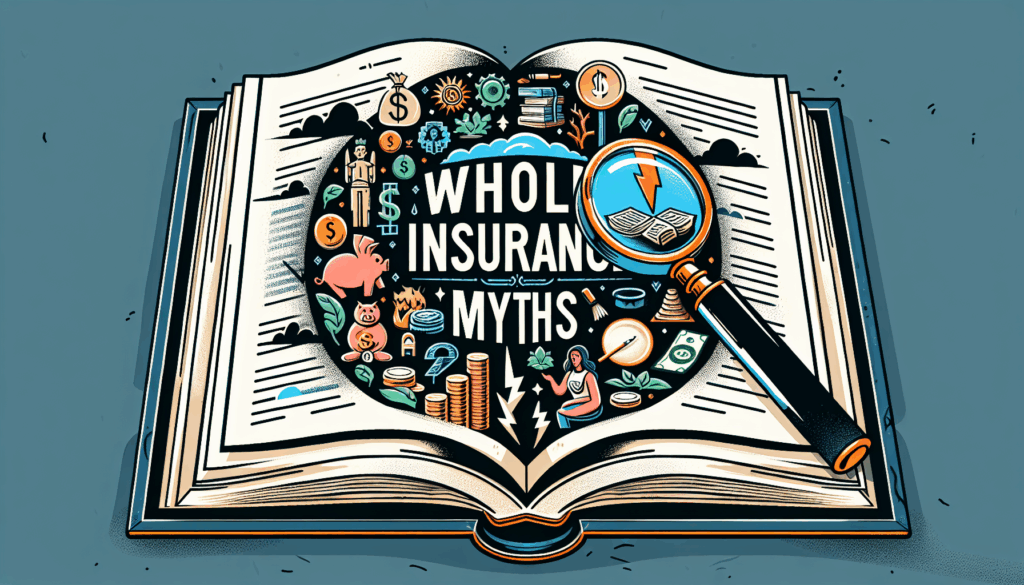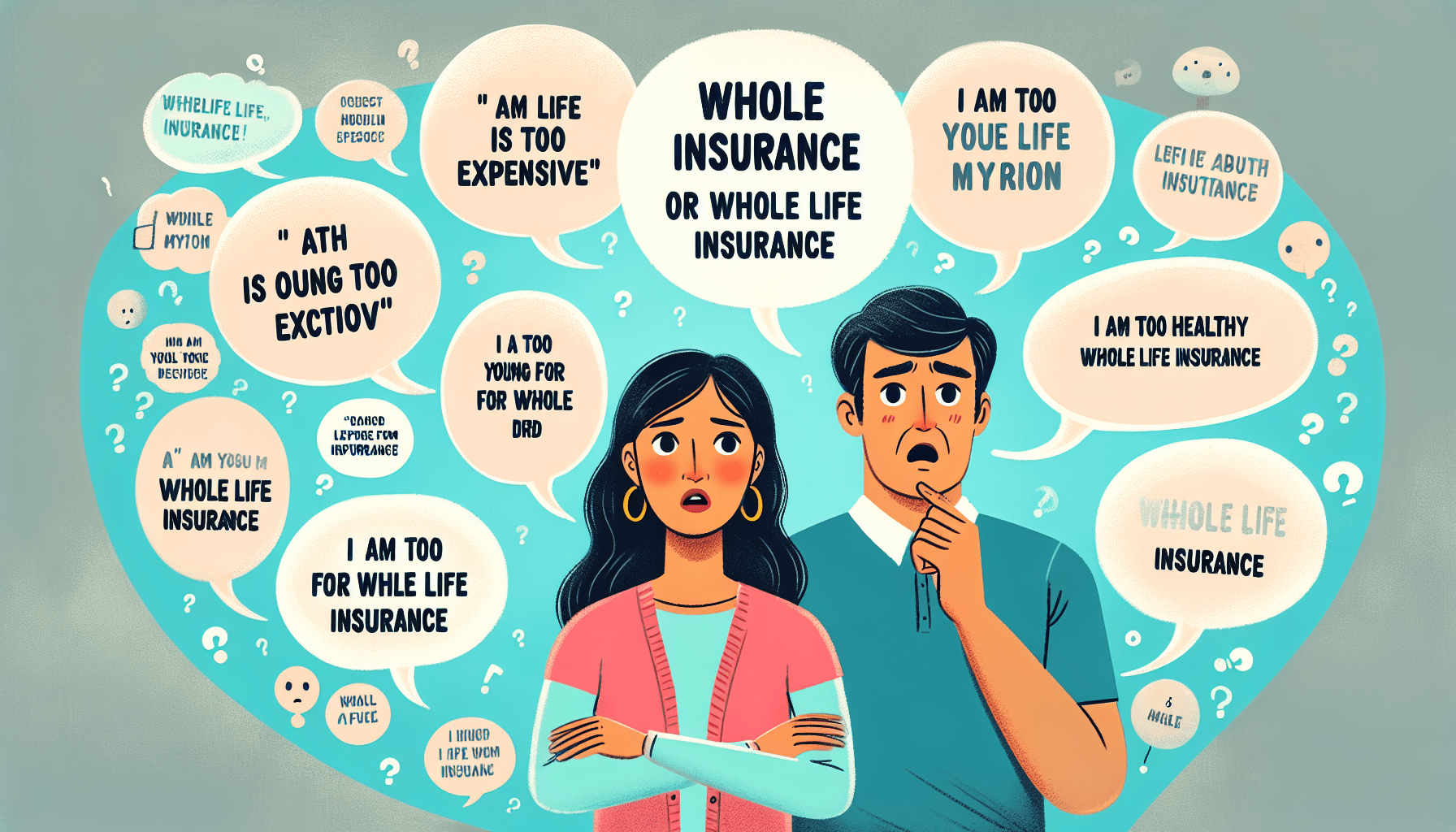Whole Life Insurance Myths
“Is whole life insurance a scam?”
Whole life insurance, often surrounded by misconceptions, is far from being a scam. It is a legitimate financial planning tool that offers a death benefit alongside a savings component, known as the cash value.
This type of insurance is designed to provide coverage for the policyholder’s entire life, as opposed to term life insurance, which covers a person for a specific period.
Critics often point to the higher premiums and complexity of whole-life policies as drawbacks, but for some individuals, the benefits of having a guaranteed payout and the potential for cash value growth outweigh these concerns.
This provocative question floods online forums, fueled by decades of misinformation. Yet, in 2025, whole life insurance remains a cornerstone of financial planning—if you understand its true value.
Unlike term insurance, which expires, whole life guarantees lifelong coverage, builds cash value, and offers tax advantages. But myths persist, costing families security and wealth. Let’s dismantle the fiction and reveal why permanent life insurance is more relevant than ever.
Myth 1: “Whole Life Insurance Is Too Expensive”

Reality: While it’s true that whole-life insurance premiums are higher than those for term life insurance, this is because whole-life policies offer lifelong protection and additional financial benefits.
The cash value that builds up within a whole life policy can be borrowed against for any purpose, providing a source of liquidity that term insurance cannot match.
Moreover, the premiums for whole life insurance remain level throughout the policyholder’s life, which can make long-term budgeting more predictable and secure. While premiums are higher than term policies, whole life’s lifelong coverage and cash value justify the cost.
1: Example: However, it is important to note that whole life insurance is not for everyone. The higher premiums can be a deterrent, especially for those who may not need coverage for their entire lives or who could benefit more from investing the difference in premiums elsewhere.
It is crucial to assess individual financial goals, current life circumstances, and future needs when considering whole life insurance as a part of a comprehensive financial plan. A 35-year-old paying 300/monthaccrues300/monthaccrues50,000+ in cash value by age 60 (Forbes).
2: Expert Insight: To delve deeper into the nuances of whole life insurance, it’s important to understand that it’s not just a safety net for your loved ones, but also a financial tool with living benefits. The cash value that accumulates over time can be borrowed for various needs such as funding education, supplementing retirement income, or even investing in business opportunities.
However, it’s essential to consult with a financial advisor to navigate the complex tax implications and borrowing details to ensure that taking advantage of these benefits doesn’t undermine the policy’s primary purpose of providing financial security. Suze Orman emphasizes, “Permanent insurance is a forced savings plan with a safety net.”
Pro Tip: To truly capitalize on the perks of permanent insurance, it’s crucial to personalize your policy to fit your unique financial landscape. This means scrutinizing your long-term goals, current assets, and any potential liabilities that might arise.
By customizing your coverage, you ensure that the policy not only serves as a robust safety net but also aligns seamlessly with your overall financial strategy, thereby optimizing the benefits for you and your loved ones. Use dividends to offset premiums. Companies like Northwestern Mutual offer participating policies.
Myth 2: “It’s Only for the Wealthy”
Reality: Life insurance is often perceived as a luxury reserved for the affluent, but this couldn’t be further from the truth. In reality, it’s a vital tool for financial protection that’s accessible to individuals and families across a wide range of income levels.
Providing a death benefit to beneficiaries ensures that your loved ones can maintain their standard of living, cover outstanding debts, and fund future needs like education or retirement, regardless of your economic status. Middle-income families benefit from estate planning and final expense coverage.
1: Case Study: In the case study, we examine the Thompson family, who represent a typical middle-income household. The Thompsons recognized the importance of estate planning and took the initiative to secure a life insurance policy that included final expense coverage.
This foresight proved invaluable when the patriarch of the family unexpectedly passed away, leaving behind a spouse and two children.
The policy not only covered funeral expenses and outstanding debts but also provided a financial cushion that helped the family maintain their lifestyle and invest in the children’s college funds. A teacher used cash value to fund her child’s college tuition, avoiding student loans (Wall Street Journal).

Myth 3: “Term Life Is Always Better”
Reality: While term life insurance is often touted for its simplicity and lower premiums, it’s not a one-size-fits-all solution. Whole life insurance, with its permanent coverage and cash value component, can serve as a lifelong financial asset, not just a death benefit.
For individuals who value stability and long-term financial planning, whole life insurance offers a predictable premium and a guaranteed growth of cash value, providing a level of financial security that term life simply cannot match. Term suits short-term needs, but whole life addresses legacy planning and lifelong dependents (e.g., special-needs children).
Comparison Table: Term vs. Whole Life
| Feature | Term Life | Whole Life |
|---|---|---|
| Duration | 10–30 years | Lifetime |
| Cash Value | No | Yes, tax-deferred |
| Premiums | Low, fixed term | Higher, fixed forever |
Debunking Top 3 Myths
1: Myth: “Cash value growth is guaranteed.”
Reality: While it is true that whole life insurance policies include a cash value component, the growth of this cash value is not always guaranteed. The return on the cash value depends on the policy’s performance and the insurance company’s investment portfolio.
Policyholders should carefully review their policy details and understand the potential for fluctuation in cash value growth over time. Growth depends on dividends/interest rates, but death benefits are guaranteed.
2: Myth: “It’s an investment vehicle.”
Reality: While life insurance can indeed have an investment component, particularly in the case of whole life and universal life policies, it’s crucial to distinguish between pure investment vehicles and insurance products. Life insurance is primarily designed to provide financial protection to your beneficiaries in the event of your untimely death.
Any cash value or investment-like aspect should be considered a supplementary feature rather than the main purpose. As such, individuals need to evaluate their financial goals and insurance needs separately and not conflate life insurance with traditional investment strategies. Cash value is a supplement, not a replacement for stocks/401(k)s.
3: Myth: “Group insurance is enough.”
Reality: While group insurance provided by an employer can be a valuable benefit, it often offers a one-size-fits-all solution that may not meet everyone’s unique needs.
Furthermore, coverage typically ends when employment does, leaving individuals without protection during gaps in employment or after retirement when it may be more difficult to obtain life insurance due to age or health.
Therefore, it’s important to assess personal circumstances and consider additional individual life insurance to ensure adequate coverage throughout one’s lifetime. Employer plans often lapse if you leave the job—your whole life stays with you.
Myth 4: “You Don’t Need It If You’re Young”
Reality: The notion that young people don’t require life insurance is a common misconception. In truth, securing a policy at a younger age can be financially advantageous, as premiums tend to be lower when you’re younger and healthier.
Furthermore, life insurance can provide crucial support to dependents or family members who might be burdened by any outstanding debts or funeral expenses in the unfortunate event of an early passing.
Therefore, it’s wise for individuals to consider their long-term financial responsibilities and the potential benefits of early life insurance coverage. Locking in lower premiums early maximizes cash value. A 25-year-old’s policy grows 5–7% annually (Investopedia).
Top Google Searches (2025)
1: “Is whole life insurance worth it?”
Given the increasing interest in whole life insurance, it’s no surprise that savvy consumers are turning to Google for insights and advice. The search query’s popularity reflects a growing awareness of the importance of financial planning and the role insurance plays in securing a stable future.
As premiums for whole-life policies are typically fixed, those who invest at a younger age can benefit from predictable costs while also building a financial asset that can be borrowed against if the need arises.
This dual advantage underscores the value proposition that whole life insurance offers, particularly to the younger demographic looking to balance long-term benefits with immediate financial flexibility. Yes, for lifelong coverage, estate planning, and supplemental retirement income.
2: “Can I borrow from my whole life policy?”
Certainly, borrowing from your whole life insurance policy is one of its most attractive features. Policyholders can take out a loan against the cash value of their policy, which can serve as a financial lifeline in times of need.
This option provides a unique blend of liquidity and security, ensuring that while you’re safeguarding your family’s future, you also have access to funds that can help you manage unforeseen expenses or investment opportunities without disrupting your long-term financial planning. Yes, loans against cash value are tax-free and flexible.
3: “What happens to cash value when I die?”
When you pass away, the policy’s death benefit is paid out to your beneficiaries. This amount typically includes the cash value that has accumulated over time, although the specifics can vary depending on the policy’s structure.
It’s important to understand that the death benefit is generally tax-free for your beneficiaries, providing them with financial security without additional tax burdens.
However, any outstanding loans against the cash value may reduce the death benefit, so it’s crucial to consider the impact of borrowing from your policy when planning for your estate. Insurers pay the death benefit; cash value is absorbed unless added via riders.
Myth 5: “Cash Value Growth is Guaranteed”
Reality: While some life insurance policies offer a guaranteed interest rate on the cash value component, it’s important to understand that the growth of cash value in many policies is subject to market performance and other factors.
Universal life policies, for instance, may offer a minimum interest rate, but the actual growth could be higher or lower depending on the prevailing economic conditions.
Therefore, policyholders should regularly review their policy’s performance and consult with their financial advisor to ensure their expectations align with the potential outcomes. Dividends depend on insurer performance. Choose mutual companies (e.g., New York Life) with 150+ years of dividend payouts.

Myth 6: “It’s Unnecessary If You Have Group Insurance”
Reality: Relying solely on group insurance can be a risky strategy, as it often provides only a basic level of coverage. Many group policies are tied to your employment, meaning you could lose your coverage if you change jobs or if your employer decides to change the benefits.
Additionally, group insurance typically does not offer the level of customization that individual life insurance policies do, which can be critical for addressing specific financial needs and goals unique to each person or family. Employer plans rarely cover final expenses or spouse’s needs post-retirement.
Essential Tips
1: Audit Policies Annually: Understanding the dynamic nature of one’s life circumstances is crucial, and an annual review of your life insurance policies ensures they align with current needs and life changes. Significant events such as marriage, the birth of a child, or a change in financial status can dramatically affect the type and amount of coverage required.
By auditing your policies regularly, you can make necessary adjustments to ensure that your coverage continues to offer the most comprehensive protection for you and your loved ones. Ensure dividends align with financial goals.
2: Ladder Policies: 3: Embrace AI Personalization: In the realm of insurance, AI personalization is revolutionizing how policies are tailored to individual needs. By leveraging artificial intelligence, insurers can analyze vast amounts of data to predict risks more accurately and offer personalized coverage options.
This means that your insurance plan can be customized to your unique lifestyle, habits, and risk profile, ensuring that you’re not overpaying for unnecessary coverage or underinsured in critical areas.
With AI-driven insights, you can receive recommendations for policy adjustments in real time, keeping your insurance aligned with life’s ever-changing circumstances. Combine term and whole life for cost efficiency.
3: Maximize Riders: Enhance Protection with Smart Riders: Riders are additional benefits you can add to your insurance policy, tailored to your specific needs.
AI personalization shines here by sifting through vast options to suggest riders that offer the most value based on your lifestyle, occupation, and long-term goals.
Whether it’s adding critical illness coverage or securing a waiver of premium for disability, AI ensures that your insurance package is not just comprehensive, but also uniquely customized for you. Add disability waivers or chronic illness riders.
Myth 7: “Whole Life is Outdated in 2025”
Reality: Reality: Contrary to this common misconception, whole life insurance continues to hold significant value even as we move through the 2020s. With its guaranteed death benefit, fixed premiums, and cash value accumulation, whole-life policies offer a level of stability and predictability that is highly sought after in an increasingly volatile economic climate.
Furthermore, AI-driven personalization can now tailor these policies to meet individual financial goals and life circumstances, ensuring that whole life insurance remains a relevant and vital component of a well-rounded financial plan. Hybrid policies now integrate long-term care and crypto-asset protection (LIMRA 2024 Report).
FAQs
1: Q: Can I convert the term to whole life?
A: Certainly! With advancements in AI personalization, policyholders are afforded greater flexibility than ever before. The conversion from term to whole life insurance is not only possible but can be tailored to match individual timelines and financial strategies.
AI-driven platforms analyze your financial data and life changes in real-time, offering recommendations for the optimal time to make the switch, ensuring that your insurance coverage evolves in tandem with your life’s progression.Yes, many insurers offer conversion riders before the age of 70.
2: Q: How are premiums calculated?
A: Premiums are typically calculated based on a variety of factors, including age, health history, occupation, and lifestyle choices. Insurers use complex algorithms that analyze these data points to assess the risk of insuring an individual and determine the cost of the coverage accordingly.
As AI personalization becomes more prevalent, these calculations can become more nuanced, taking into account a broader range of variables and even predicting future risks based on current trends and behaviors.
This results in more accurate pricing for both the insurer and the insured, reflecting a truly individualized approach to insurance underwriting. Age, health, and coverage amount. Non-smokers save 20–30%.

Conclusion
The transformative power of AI personalization doesn’t just stop at pricing, however. It extends to customer service and claims processing, offering a more tailored and efficient experience.
By analyzing customer data, AI can anticipate needs, automate routine inquiries, and expedite claims, thereby reducing wait times and enhancing overall satisfaction.
Insurers that leverage this technology are not only able to differentiate themselves in a competitive market but also build stronger, more trusting relationships with their clients.
Whole life insurance isn’t a relic—it’s a dynamic tool for 2025’s financial challenges. By debunking myths, you unlock lifelong security and growth. Act now: Consult a fiduciary advisor to tailor a policy to your legacy.
Join the Discussion: Has whole life insurance helped your financial strategy? Share below!

